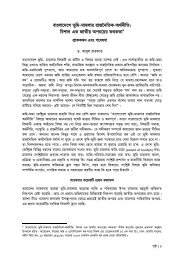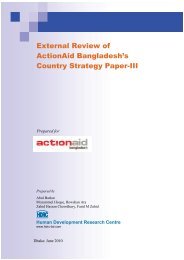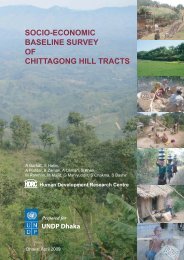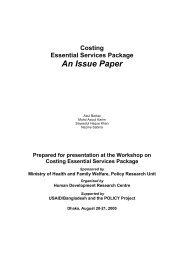situation analysis of chittagong hill tracts in bangladesh
situation analysis of chittagong hill tracts in bangladesh
situation analysis of chittagong hill tracts in bangladesh
You also want an ePaper? Increase the reach of your titles
YUMPU automatically turns print PDFs into web optimized ePapers that Google loves.
SITUATION ANALYSIS<br />
OF<br />
CHITTAGONG HILL TRACTS<br />
IN BANGLADESH<br />
(An Analysis Based on “Socio-Economic Basel<strong>in</strong>e Survey <strong>of</strong><br />
Chittagong Hill Tracts” Data)<br />
Abul Barkat<br />
Avijit Poddar<br />
Md. Badiuzzaman<br />
Asmar Osman<br />
Prepared for<br />
Save the Children<br />
UK<br />
Dhaka: June 25, 2008
Introduction<br />
Executive Summary<br />
The Chittagong Hill Tracts (CHT) is situated <strong>in</strong> the southeastern part <strong>of</strong> Bangladesh, covered<br />
with lush green <strong>hill</strong>s, <strong>in</strong>numerable jharnas (scattered founta<strong>in</strong>s) and hundreds <strong>of</strong> choras<br />
(mounta<strong>in</strong> streamlets); and is surrounded by Myanmar and Mizoram (India) <strong>in</strong> the east,<br />
Tripura (India) <strong>in</strong> the north, districts <strong>of</strong> Chittagong and Cox's Bazar <strong>in</strong> the west and south<br />
respectively. It has a total land area <strong>of</strong> about 13,294 square km (about 10% <strong>of</strong> land area <strong>in</strong><br />
Bangladesh) and a population <strong>of</strong> about 1.3 million (BBS 2001). Adm<strong>in</strong>istratively, CHT<br />
comprises <strong>of</strong> three <strong>hill</strong> districts: Banadarban, Khagrachari and Rangamati. There are twelve<br />
ethnicities (11 <strong>in</strong>digenous and Bangalees) liv<strong>in</strong>g <strong>in</strong> CHT. The eleven ethnic multi-l<strong>in</strong>gual<br />
m<strong>in</strong>orities are: Bawm, Chak, Chakma, Khyang, Khumi, Lushai, Marma, Mro, Pangkhua,<br />
Tangchangya, and Tripura.<br />
The current study is based on the secondary <strong>analysis</strong> <strong>of</strong> “Socio-economic Basel<strong>in</strong>e Survey <strong>of</strong><br />
Chittagong Hill Tracts (CHT)” 1 sponsored by UNDP-CHTDF. The current study <strong>in</strong>itiated by<br />
the Save the Children (UK) has been conceived for atta<strong>in</strong><strong>in</strong>g a wider understand<strong>in</strong>g <strong>of</strong> various<br />
aspects <strong>of</strong> life <strong>of</strong> the people liv<strong>in</strong>g <strong>in</strong> Chittagong Hill Tracts.<br />
Methodological Discussions<br />
‘The Socio-economic Basel<strong>in</strong>e Survey <strong>of</strong> CHT’ was conducted us<strong>in</strong>g a representative sample<br />
<strong>of</strong> all 12 ethnicities liv<strong>in</strong>g <strong>in</strong> CHT. The study has generated the data/<strong>in</strong>formation from 3238<br />
households and covered well dispersed 199 paras <strong>in</strong> 29 unions, 13 Upazillas and all the three<br />
CHT districts. The study was conducted dur<strong>in</strong>g September 2007 to May 2008. It is to note<br />
although the sample as a whole and by ethnicities was representative <strong>of</strong> all CHT, district wise<br />
representativeness was not adhered. However, for the accompany<strong>in</strong>g <strong>situation</strong> <strong>analysis</strong>, an<br />
attempt has been made to disaggregate the data by districts and with<strong>in</strong> the districts by broader<br />
population categories, such as <strong>in</strong>digenous and Bangalees. Therefore, the f<strong>in</strong>d<strong>in</strong>gs are<br />
completely <strong>in</strong>dicative and to be understood with appropriate cautions. The data/<strong>in</strong>formation<br />
generated <strong>in</strong> the basel<strong>in</strong>e survey <strong>of</strong> CHT is focused on the households and there is no children<br />
specific data <strong>in</strong> that study.<br />
Key F<strong>in</strong>d<strong>in</strong>gs<br />
About 62% households <strong>in</strong> the region irrespective <strong>of</strong> ethnicities are liv<strong>in</strong>g below absolute<br />
poverty l<strong>in</strong>e (below 2,122 kcal), while 36% are hardcore poor (below 1,805 K.cal). Poverty is<br />
slightly less pronounced among the Banglaees. A 59% <strong>of</strong> Bangalee households are absolutely<br />
poor and 31% are hardcore poor. No major variation <strong>in</strong> terms <strong>of</strong> poverty <strong>in</strong>cidences have<br />
been revealed across the districts.<br />
A close to two-thirds <strong>of</strong> the current Bangalee population <strong>in</strong> CHT is transmigrated people.<br />
Around 31% <strong>of</strong> rural CHT households had to change their usual place <strong>of</strong> residences at least<br />
once <strong>in</strong> their life-time and the average number <strong>of</strong> shift<strong>in</strong>g is 1.7 times. 38% <strong>of</strong> all <strong>in</strong>digenous<br />
1 Barkat Abul et al. (2008). Socio-Economic Basel<strong>in</strong>e Survey <strong>of</strong> Chittagong Hill Tracts, conducted for UNDP-CHTDF,<br />
(Unpublished Draft Report) by Human Development Research Centre (HDRC), Dhaka.
HDRC<br />
Situation Analysis <strong>of</strong> Chittagong Hill Tracts <strong>in</strong> Bangladesh<br />
households had to shift for almost 2 times. Dur<strong>in</strong>g 1997-2007, an average Bangalee<br />
household had to move from their first permanent residence <strong>in</strong> CHT about 1.4 times. The<br />
highest occurrences <strong>of</strong> out-migration took place <strong>in</strong> Khagrachari (46%) followed by<br />
Rangamati (25%) and Bandarban (21%).<br />
Land ownership <strong>of</strong> a household <strong>in</strong> context <strong>of</strong> CHT is to be understood along with three major<br />
types <strong>of</strong> ownership: (i) <strong>in</strong>dividual registered ownership, (ii) traditional ownership under<br />
(recorded and/or not recorded with headman) under usufruct rights, and (iii) usufruct rights to<br />
ownership <strong>of</strong> common property (different from that <strong>in</strong> pla<strong>in</strong> land). Irrespective <strong>of</strong> ethnicity,<br />
95% households own some land (<strong>in</strong>clud<strong>in</strong>g common property).<br />
An average rural household <strong>in</strong> CHT owns about 200 decimals <strong>of</strong> land (all types <strong>of</strong> land<br />
exclud<strong>in</strong>g common property). The highest amount <strong>of</strong> land i.e., about 244 decimals <strong>of</strong> land<br />
owned by an average household <strong>in</strong> Bandarban followed by Rangamati (196 decimal). The<br />
lowest amount <strong>of</strong> land (164 decimals) owned by people liv<strong>in</strong>g <strong>in</strong> Khagrachari district. An<br />
<strong>in</strong>digenous household owns about 254 decimals which is almost double <strong>of</strong> a Bangalee<br />
household (136 decimals) <strong>in</strong> rural CHT. Indigenous households possess significantly higher<br />
amount <strong>of</strong> land compared to the Bangalees <strong>in</strong> all three districts <strong>of</strong> CHT. In Bandarban<br />
Bangalee households possess about 67 decimals <strong>of</strong> agricultural (plough) land while an<br />
<strong>in</strong>digenous household possesses 48 decimals. In Rangamati, difference <strong>in</strong> agricultural<br />
(plough) land ownership between Bangalee and <strong>in</strong>digenous household is prom<strong>in</strong>ent where an<br />
average <strong>in</strong>digenous household possesses almost two times higher amount <strong>of</strong> land (39<br />
decimal) compared to that <strong>of</strong> Bangalee (20 decimals). Besides this scenario, <strong>in</strong> Khagrachari<br />
district Bangalee and <strong>in</strong>digenous households possess almost equal amount <strong>of</strong> agricultural<br />
(plough) land (around 45 decimals). Higher amount <strong>of</strong> ownership <strong>of</strong> jum land has been found<br />
<strong>in</strong> <strong>in</strong>digenous community compared to Bangalee <strong>in</strong> all three districts <strong>in</strong> the CHT. The highest<br />
amount <strong>of</strong> jum land owned by <strong>in</strong>digenous households has been found as 102 decimals <strong>in</strong><br />
Bnadarban district followed by Rangamati (66 decimals) and Khagrachari (46.5 decimals).<br />
Fr<strong>in</strong>ge land has been found prom<strong>in</strong>ently <strong>in</strong> Rangamati district where about 35 decimals <strong>of</strong><br />
such land owned by a household and <strong>in</strong>digenous household possesses more land compared to<br />
Bnagalee household by an amount <strong>of</strong> 11 decimals.<br />
In rural CHT, almost all households possess own house. On average, a Bangalee household<br />
owns assets worth Taka 61,730, which is 30% higher than that among average <strong>in</strong>digenous<br />
HH. The majority (63%) <strong>of</strong> the houses <strong>of</strong> <strong>in</strong>digenous communities are kancha, among the<br />
Bangalees 96% houses are kancha. Straw/jute stick/leaves/chaan has been used as the ma<strong>in</strong><br />
ro<strong>of</strong> construction material more frequently than that among the Bangalees. Bamboo is the<br />
most frequently used wall construction material for both among the <strong>in</strong>digenous and Bangalee.<br />
More than 80% <strong>of</strong> the households <strong>in</strong> CHT do not have electricity irrespective <strong>of</strong> the three<br />
districts <strong>in</strong> this region.<br />
On average, 2.75 person <strong>in</strong> a household (HH size is 5.2), that is 52% <strong>of</strong> the total household<br />
members is either employed or employable. One-fifth <strong>of</strong> the employable people on CHT<br />
irrespective <strong>of</strong> <strong>in</strong>digenous peoples and Bangaless are unemployed. This pattern <strong>of</strong> high<br />
unemployment is similar among the three districts <strong>in</strong> CHT. In rural CHT, about 9%<br />
households are female-headed. An average year <strong>of</strong> school<strong>in</strong>g is around 5 years <strong>in</strong> CHT,<br />
irrespective <strong>of</strong> <strong>in</strong>digenous peoples and Bangalees. This is also similar among the three<br />
districts <strong>in</strong> CHT. Only 7.8 % CHT people completed primary education and 2.4% completed<br />
secondary education. One-third households are <strong>in</strong>volved <strong>in</strong> field cropp<strong>in</strong>g only, about onefifth<br />
are <strong>in</strong>volved <strong>in</strong> jum only, and a small portion (9%) does both field and jum agriculture.<br />
ii
HDRC<br />
Situation Analysis <strong>of</strong> Chittagong Hill Tracts <strong>in</strong> Bangladesh<br />
Plough and jum cultivation has been found <strong>in</strong> more than 50% <strong>of</strong> all <strong>in</strong>digenous households,<br />
while most Bangalee households depend on plough agriculture.<br />
The average annual net <strong>in</strong>come <strong>of</strong> a rural household <strong>in</strong> the region irrespective <strong>of</strong> ethnicities is<br />
about Tk. 65,852, while the same <strong>in</strong> rural Bangladesh (at the current price <strong>of</strong> January 2008) is<br />
about 1.28 times higher. Field cropp<strong>in</strong>g as source <strong>of</strong> <strong>in</strong>come has been reported by<br />
substantially higher proportion <strong>of</strong> Bangalee households <strong>hill</strong> districts <strong>of</strong> Bandarban and<br />
Rangamati compared to their <strong>in</strong>digenous counterparts. However, <strong>in</strong> Khagrachari the scenario<br />
is reverse (53% vs. 40%). Jum cultivation is the second most pronounced source <strong>of</strong> <strong>in</strong>come<br />
across the districts. It is to note that <strong>in</strong> Bandarban the share <strong>of</strong> households report<strong>in</strong>g jum as<br />
source <strong>of</strong> <strong>in</strong>come is made by higher proportion <strong>of</strong> households compared to field cropp<strong>in</strong>g.<br />
The household annual expenditure <strong>in</strong> rural CHT is lower than that <strong>of</strong> rural Bangladesh (Tk.<br />
62,000 vs. 73,000). The share <strong>of</strong> food expenditure is extremely high across the communities<br />
compris<strong>in</strong>g about 90% <strong>of</strong> total household expenditure. The annual household expenditure on<br />
health and education for an average household is extremely low with Tk.605 and Tk.398<br />
respectively.<br />
In terms <strong>of</strong> per capita sav<strong>in</strong>gs, an average household member has Tk.702, while an average<br />
<strong>in</strong>digenous people household member possesses Tk.467 and Bangalee household member;<br />
Tk.890. NGOs have been appear<strong>in</strong>g as a place <strong>of</strong> deposit<strong>in</strong>g sav<strong>in</strong>gs for both Bangalees<br />
(46%) and <strong>in</strong>digenous peoples (30%). About 54% <strong>of</strong> all CHT households reported some<br />
access to credit. The Bangalees have higher access to credit as compared to the <strong>in</strong>digenous<br />
communities.<br />
The physical quantity <strong>of</strong> daily food <strong>in</strong>take per person <strong>in</strong> CHT is about 781 gm. The average<br />
daily per capita food <strong>in</strong>take <strong>of</strong> Bangalee household is higher (800 gm), which is 769 gm<br />
among the <strong>in</strong>digenous communities. In terms <strong>of</strong> energy <strong>in</strong>take <strong>of</strong> food, people liv<strong>in</strong>g <strong>in</strong> rural<br />
CHT use to have 1,798 K.cal per day which is less than the level <strong>of</strong> the hardcore poor (below<br />
1805 Kcal). The average per capita daily energy <strong>in</strong>take status <strong>of</strong> the Bangalees (1,842 K.cal)<br />
is slightly better than the <strong>in</strong>digenous communities (1,762 K.cal) but still under the level <strong>of</strong> the<br />
absolute poor (below 2,122 K.cal).<br />
About one-fourth <strong>of</strong> the respondents have reported that there is no school <strong>in</strong> the para or <strong>in</strong><br />
close proximity to the community. About 82% children <strong>of</strong> 5-16 years are enrolled <strong>in</strong> primary<br />
or secondary school. The enrollment among the Bangalees is marg<strong>in</strong>ally higher than that<br />
among the <strong>in</strong>digenous peoples. The dropout scenario among the students is deplorable with<br />
65% households report<strong>in</strong>g about discont<strong>in</strong>uation <strong>of</strong> children’s education before completion <strong>of</strong><br />
primary and 19% after primary.<br />
Peoples’ knowledge status about health problems and about the facilities and providers to go<br />
for care if these health problems occur is simply deplorable. Their awareness is very low on<br />
how to prepare ORS, ANC checkup, PNC checkup, and delivery by medically tra<strong>in</strong>ed<br />
provider, place to go for child vacc<strong>in</strong>ation, ARI treatment <strong>of</strong> child, and place to go for<br />
treatment. Malaria has been pronounced more compared to other diseases <strong>in</strong> the CHT with a<br />
little variation among the districts. The highest number <strong>of</strong> <strong>in</strong>cidence <strong>of</strong> malaria has been<br />
found to be 3.5 <strong>in</strong> Bandarban followed by Rangamati (2.6) and Khagrachari (2.1). The<br />
contraceptive prevalence rate is 54%, and the unmet need for family plann<strong>in</strong>g is 12%.<br />
Therefore, as aga<strong>in</strong>st 73% demand for family plann<strong>in</strong>g nationally, the rate is 66% <strong>in</strong> CHT.<br />
Insignificant number <strong>of</strong> deliveries takes place <strong>in</strong> health facilities.<br />
iii
HDRC<br />
Situation Analysis <strong>of</strong> Chittagong Hill Tracts <strong>in</strong> Bangladesh<br />
Majority <strong>of</strong> the households irrespective <strong>of</strong> districts <strong>in</strong> the CHT use unsafe dr<strong>in</strong>k<strong>in</strong>g water.<br />
This trend is same for <strong>in</strong>digenous peoples and Bangalees. But the source <strong>of</strong> dr<strong>in</strong>k<strong>in</strong>g water<br />
varies among the districts <strong>in</strong> CHT due to geographical variations.<br />
In CHT, irrespective <strong>of</strong> variations among the three districts, all the household members still<br />
do not use any type <strong>of</strong> latr<strong>in</strong>e. Unhygienic pit latr<strong>in</strong>e is possessed by 51% <strong>of</strong> the households<br />
irrespective <strong>of</strong> <strong>in</strong>digenous groups and Bangalees <strong>in</strong> Rangamati, which is 44% <strong>in</strong> Khagrachari.<br />
Conclusions and Recommendations<br />
The f<strong>in</strong>d<strong>in</strong>gs <strong>of</strong> the study depict the deplorable conditions <strong>of</strong> the people liv<strong>in</strong>g <strong>in</strong> the<br />
Chittagong Hill Tracts Region irrespective <strong>of</strong> their geographic locations (districts) as well as<br />
ethnic identity (<strong>in</strong>digenous or Bangalees). It is to note that household level <strong>in</strong>formation by<br />
children category is not generated and therefore deprivation status <strong>of</strong> children is not covered.<br />
On the backdrop <strong>of</strong> the f<strong>in</strong>d<strong>in</strong>gs presented above, it is suggested to undertake separate studies<br />
on children related issues by communities and locations. Moreover, the path f<strong>in</strong>d<strong>in</strong>g nature <strong>of</strong><br />
the current study, it is recommended to undertake <strong>in</strong> depth household level survey on bamboo<br />
flower<strong>in</strong>g and rodent attack and its impact on (i) food consumption and, (ii) agricultural<br />
cultivation, <strong>in</strong>come, and employment; and (iii) livelihood status <strong>of</strong> rural CHT.<br />
iv






